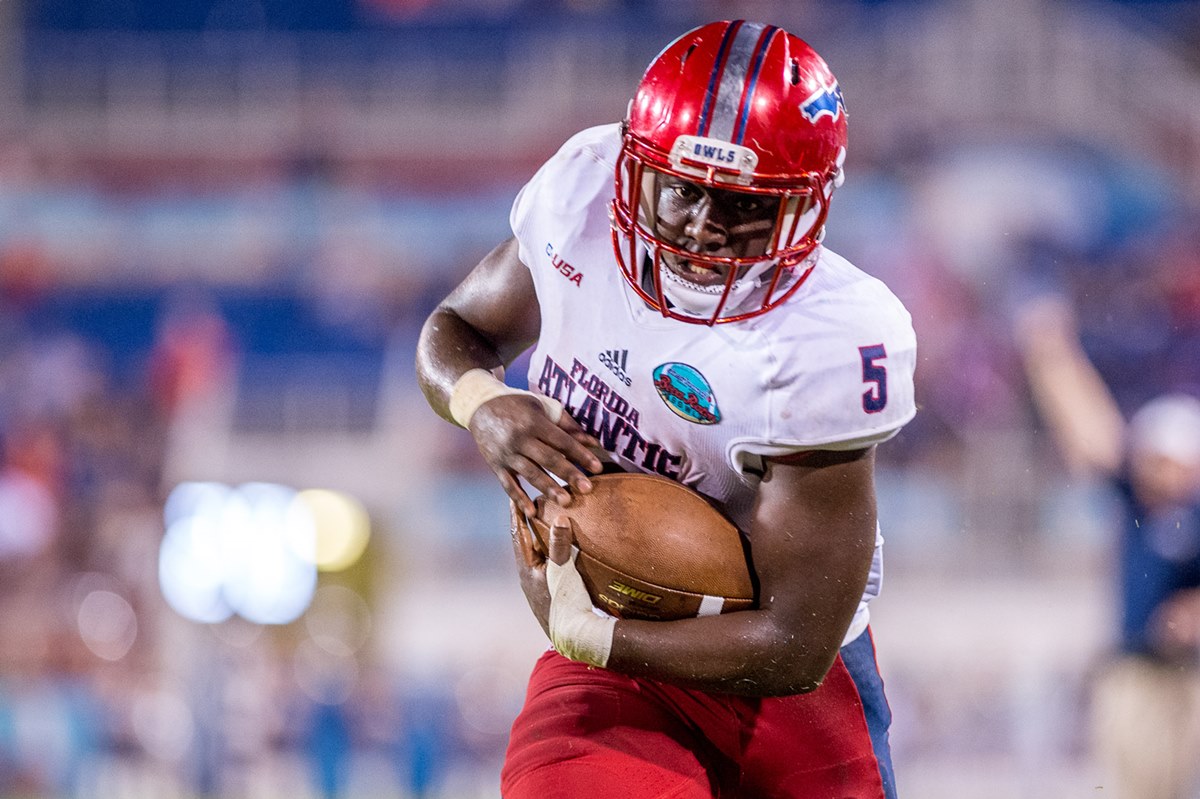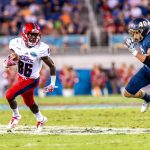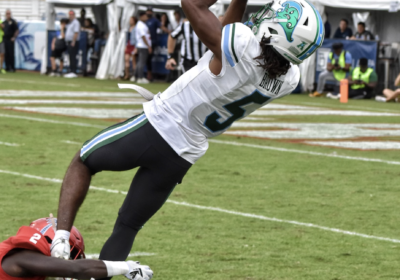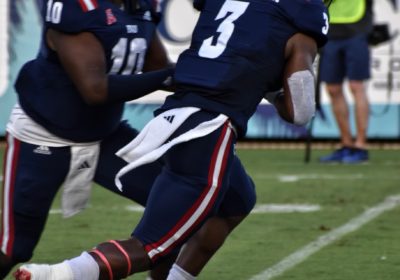[the_ad_group id=”632″]
BOCA RATON – Unlike the quarterback position, there isn’t any uncertainty concerning the Owls’ top ball carrier.
Devin Singletary isn’t simply FAU’s best back, his combination of strength, shiftiness and vision make him one of the best running backs in the nation – and an underdog candidate for the Heisman Trophy entering the 2018 season.
After splitting time with Buddy Howell as a freshman, Singletary raced and darted to 1,920 yards and an NCAA-leading 32 rushing touchdowns last season. Only three players in NCAA football history ever rushed for more in a single season.
Singletary figures to be the heart of FAU’s offense once again in 2018. The big question is, How does the running back position shake out behind him?
As Singletary’s backup last season, Howell scored five touchdowns and averaged 6.6 yards per carry. Now a Miami Dolphin, Howell’s departure left a hole in the Owls’ depth chart.
Injuries further clouded the depth chart during spring practice.
Coach Lane Kiffin spoke glowingly about then-true freshman Tyrek Tisdale last fall, and Tisdale averaged 4.3 yards on his seven carries early last year. But in the third game of the season against Bethune-Cookman, Tisdale suffered a knee injury while returning a kickoff. That knee kept him from competing in spring drills.
Understanding that his Owls would be shorthanded at the running back position during the spring, Kiffin elected to move D’Anfernee McGriff from tight end to running back. Powerful and faster than he looks, McGriff displayed some skill there, but he, too, suffered an undisclosed injury during spring workouts that kept him out of the spring game.
Explosive third-down back Kerrith Whyte remained in that role throughout most of spring, and with Singletary dealing with a mild hamstring issue, FAU elevated little used Gerald Hearns to the first team for the spring game.
Last year Kiffin displayed a reluctance to simply hand unproven players spots on the two-deep, so Hearns, generously listed a 5-foot-8, may well begin fall camp as the second-string running back. But Tisdale and McGriff are bigger backs in the mold of Howell. They should soon surpass Hearns, as might a Malcolm Davidson and B. J. Emmons – a couple of talented newcomers.
OwlAccess.com Pre-Camp RB Breakdown
DEPTH CHART
Devin Singletary (5-9, 200, Jr.): Last season’s C-USA MVP, Singletary posted video game statistics the likes of which had never before seen at FAU. Currently third on FAU’s career rushing list, Singletary needs only 616 yards to pass Alfred Morris as the Owls’ all-time leading rusher. Last season Singletary averaged 137.1 yards per game. He’ll be looking for a repeat performance while getting the ball from a yet-to-be-determined quarterback, and running behind an unproven, overhauled offensive line.
Tyrek Tisdale (6-0, 210, So,): Kiffin found success last season countering Singletary’ shiftiness with Howell’s power. Like Howell, Tisdale is a bigger back with speed. Several times last season Kiffin mentioned Tisdale as potentially being an NFL running back. If his knee is healthy, this is Tisdale’s spot to lose.
-OR-
Kerrith Whyte (5-10, 200): Already a proven back-up, Whyte thrived as a third-down back during his first two seasons. A threat catching the ball and on runs outside the tackles, Whyte averaged 5.0 yards on his 98 carries during his first two seasons. Whyte will find a way to be involved in the offense.
D’Anfernee McGriff (6-1, 215, Jr.): McGriff came to FAU as a wide receiver, but as his bulk increased to more than 230 pounds the Owls switched him to tight end. Spring brought another move. McGriff is an upright runner vulnerable to punishment at the line of scrimmage. He’s also powerful when he gets low, deceptively fast and possesses good hands. Kiffin is looking for ways to incorporate McGriff’s skill set. If other running backs step up, a return to tight end or wide receiver isn’t out of the question.
Gerald Hearns (5-8, 208, R-Sr.): Considering the way spring ended, Hearns could actually start camp as the Owls’ second-string running back, but he’s unlikely to stay there. An energetic presence on the field, Hearns profiles more as a third down back. If other running backs arrive at camp healthy, Hearns will quickly drop on the depth chart.
KEY ADDITIONS
Malcolm Davidson (5-10, 180, Fr.): He didn’t arrive in Boca Raton at the same time as most other members of the Owls’ 2018 signing class, but Davidson is on the roster now. The Owls are high on Davidson’s ability to turn any run into a big play. How much playing time he sees might depend on the health and success of the players listed on the above depth chart, and a redshirt season appears to be a strong possibility. However, if Davidson is what the Owls think he is, Kiffin won’t hesitate to give him the ball.
B. J. Emmons (6-0, 235, Jr.): He’s still completing academic work and is not officially an Owl yet, but come August FAU expects him to be in Boca Raton. Emmons played under Kiffin at Alabama before transferring to Hutchinson Community College. He’s strong and explosive, possessing the kind of raw talent rarely seen in a Conference USA running back (except, of course, for his teammate at the top of the depth chart).
KEY LOSSES
Buddy Howell: The fourth-leading rusher in program history, Howell signed with the Miami Dolphins as an undrafted free agent. He was able to spell Singletary without the Owls’ offense missing a step. FAU will also miss Howell’s personality and unselfishness. He did whatever FAU asked to help the Owls win.
BREAKOUT CANDIDATE
B. J. Emmons: The pedigree is there. Emmons averaged 4.9 yards on 35 carries as a freshman with the Crimson Tide in 2016 before electing to transfer. He’ll be reunited with Kiffin, his former offensive coordinator. Emmons is the biggest risk/reward candidate in this unit. FAU is expecting him, but fulfilling the academic requirements to transfer from junior collage to FAU, especially this late in the process, often proves more problematic than expected. And Emmons struggled to hang onto the football last season, fumbling seven times and losing four of them. Still, the talent that made him a priority recruit for Alabama remains. Emmons is a wildcard. If he comes up aces, the Owls’ offense will cash in.
PREVIOUS FAU POSITION PREVIEWS







Leave a Reply